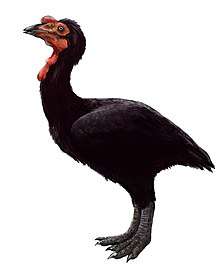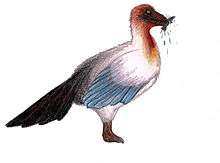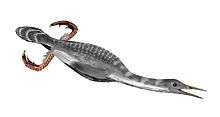Hesperornithoides
Hesperornithoides (meaning "western bird form"; nicknamed "Lori") is a genus of troodontid theropod dinosaur that lived in North America during the Late Jurassic period.[1]
| Hesperornithoides | |
|---|---|
 | |
| Main blocks of the holotype | |
| Scientific classification | |
| Kingdom: | Animalia |
| Phylum: | Chordata |
| Clade: | Dinosauria |
| Clade: | Saurischia |
| Clade: | Theropoda |
| Family: | †Troodontidae |
| Genus: | †Hesperornithoides Hartman et al., 2019 |
| Species: | †H. miessleri |
| Binomial name | |
| †Hesperornithoides miessleri Hartman et al., 2019 | |
Discovery

In 2001, a field crew from the Tate Museum supervised by William Wahl unexpectedly discovered the fossil in rocks of the Jimbo Quarry of the Morrison Formation, overlying the excavation site of Supersaurus vivianae, near Douglas, Wyoming. The stratigraphic position of the site was carefully documented by the collectors and detailed in Lovelace, 2006.[2] Its discovery was announced at the 2003 annual meeting of the Society of Vertebrate Paleontology. In 2005, a phylogenetic analysis including it was presented in an abstract for the Journal of Vertebrate Paleontology.[3] The same year the specimen was donated to the Big Horn Basin Foundation which in 2016 joined the Wyoming Dinosaur Center.[1]
In 2019, the type species Hesperornithoides miessleri was named and described by Scott Hartman, Mickey Mortimer, William Wahl, Dean R. Lomax, Jessica Lippincott and David M. Lovelace. The generic name is derived from the Greek Ἑσπερίς, Hesperis, "western", ὄρνις, ornis, "bird", and ~eides, "form". The specific name honours the Miessler family for its support of the project. The holotype, WYDICE-DML-001, was found in a layer of the middle Morrison Formation dating from the Tithonian. It consists of a partial skeleton containing the rear skull and lower jaws, hyoid bones, five neck vertebrae, the first back vertebra, twelve tail vertebrae, a rib, chevrons, the left shoulder girdle, the right humerus, the left arm, a thighbone piece, and the left and right lower legs minus the right toes. The skeleton was partially articulated, representing a subadult or adult individual.[1]
Description
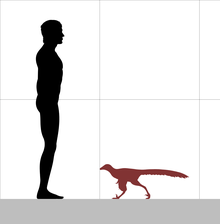
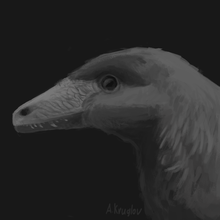
The length of the holotype individual was in 2019 estimated at 89 cm (35 in) long. Such a body size is rather limited for a troodontid. The specimen may represent an adult or subadult individual, due to the lack of cranial and body proportions associated with juvenile individuals. Nevertheless, either assignation would not be much different; for instance, the estimated 89 cm (35 in) would become 1 m (3.3 ft). The describing authors established some derived or apomorphic traits relative to the Paraves. The jugal bone is pneumatised. The rear branch of the lacrimal bone is short, with less than 15% of the length of the descending branch, measured from the inner corner downwards. The quadrate bone is part of the outer edge of the foramen paraquadraticum. In the lower jaw the external side opening is small, with less than an eighth of the length of the jaw as a whole. On the humerus, the ridge towards the inner condyle represents more than 15% of the total distal width of the element. The third claw of the hand is about as large as the second claw. The lower inner corner of the shinbone projects to the front.[1]
Classification
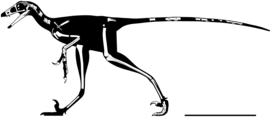
The phylogenetic analysis of 2005 placed the specimen as a close relative of Sinornithoides.[3] Unpublished phylogenetic results presented at the SVP 2017 conference recovered Hesperornithoides (then known by the informal name "Lori") as a relative of Sinovenator.[4] The presence of this derived maniraptoran along with several others, such as Anchiornis and Eosinopteryx, in Jurassic sediments was a strong refutation of the temporal paradox argument used by those who oppose the consensus view that birds evolved from dinosaurs.[1]
In 2019, Hesperornithoides was placed in the Troodontidae, in a relatively basal position, in a clade with Daliansaurus, Xixiasaurus and Sinusonasus, as shown in the cladogram below:[1]
| Troodontidae |
| |||||||||||||||||||||||||||||||||||||||
Palaeobiology
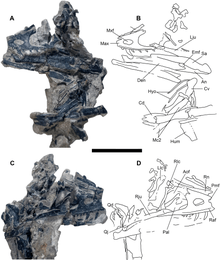
Many large dinosaurs have been discovered in the Morrison Formation during the nineteenth century; Hesperornithoides proves that the full wealth of species had not yet been revealed. It lived in a relatively open well-watered landscape with low growths but few trees, or, lacustrine and wetland environments.[1][5]
Apart from the Avialae, most paravian groups had only few members with some flight capability. The exceptions all showed adaptations for an arboreal lifestyle, indicating flight developed multiple times when species evolved traits and behaviours useful for climbing trees or other more vertical surfaces, such as wing-assisted incline running.[1]
References
- Hartman, Scott; Mortimer, Mickey; Wahl, William R.; Lomax, Dean R.; Lippincott, Jessica; Lovelace, David M. (2019). "A new paravian dinosaur from the Late Jurassic of North America supports a late acquisition of avian flight". PeerJ. 7: e7247. doi:10.7717/peerj.7247. PMC 6626525. PMID 31333906.
- Lovelace, D.M. (2006). "An Upper Jurassic Morrison Formation fire-induced debris flow: Taphonomy and paleoenvironment of a sauropod (Sauropoda: Supersaurus vivianae) locality, east-central Wyoming." pp. 47–56 in Foster, J.R., and Lucas, S.G., eds. (2006), Paleontology and geology of the Upper Jurassic Morrison Formation. New Mexico Museum of Natural History and Science Bulletin 36.
- Hartman, S., Lovelace, D., and Wahl, W., (2005). "Phylogenetic assessment of a maniraptoran from the Morrison Formation." Journal of Vertebrate Paleontology, 25, Supplement to No. 3, pp. 67A–68A http://www.bhbfonline.org/AboutUs/Lori.pdf Archived 2012-07-26 at the Wayback Machine
- http://vertpaleo.org/Annual-Meeting/Annual-Meeting-Home/SVP-2017-program-book-7-20-17a-(1).aspx
- Black, Riley. "Discovery of Raptor-Like Dinosaur Adds a New Wrinkle to the Origin of Birds". Smithsonian. Retrieved 2019-07-12.
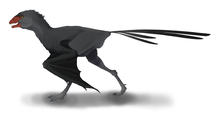
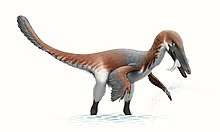
.png)
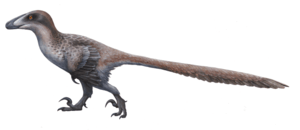

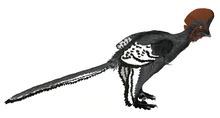
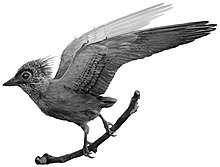

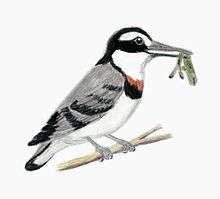
.png)
